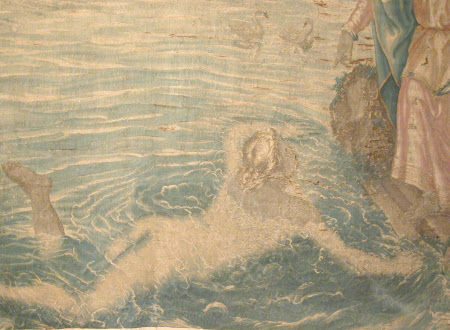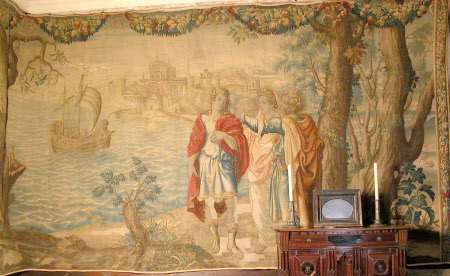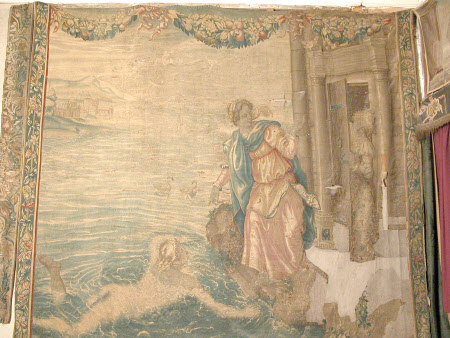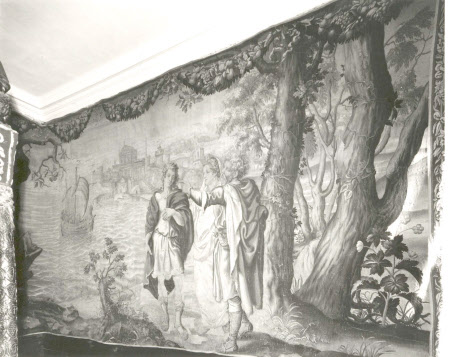The Story of Hero and Leander
Mortlake Tapestry Manufactory
Category
Tapestries
Date
circa 1660 - circa 1690
Materials
Tapestry, wool and silk, 7 warps per cm
Place of origin
Mortlake
Order this imageCollection
Cotehele, Cornwall
NT 348324
Summary
A set of three tapestries of the Story of Hero and Leander, tapestry, wool and silk, 7 warps per cm, Mortlake, after a design by Francis Cleyn, c. 1660-1690.
Full description
The story of Hero and Leander was told by the 5th-century poet Musaeus, and is also alluded to in Ovid’s Metamorphoses. The source for the tapestries is almost certainly a poem written by Christopher Marlowe, based on the first half of Musaeus’s story, and extended by George Chapman to complete the narrative the joint work first published in 1598. The young lovers Hero and Leander lived on opposite sides of the Hellespont, Leander at Abydos on the Turkish side, and Hero at Sestos on the Greek side where she was a priestess at a Temple devoted to the Goddess Aphrodite (Venus). It was here that the lovers first met, and their meeting is the subject of the first tapestry in the series, which does not survive at Cotehele. The second tapestry, which again does not survive at Cotehele, shows Leander setting off to swim the Hellespont to meet Hero at her tower on the opposite shore. His sister Hermione stands on the shore wringing her hands as she watches him depart, his pile of clothes on the ground beside her. The next scene, which does survive at Cotehele (348324.2), shows Leander arriving at Hero’s tower. After returning from his first visit to Hero Leander confided in his parents and obtained their blessing to marry Hero, the subject of the fourth tapestry (348324.1). The fifth tapestry, which does not survive at Cotehele, shows Leander about to swim the Hellespont one last time, by night: he strides into the water, again watched by the anxious Hermione. Hero had vowed to keep a light burning in her tower to guide him but the light was extinguished in a storm, which killed Leander, and the final tapestry in the series shows Leander’s dead body washed up on the shore at Sestos and the distraught Hero dying of despair (348324.3). The ‘Hero and Leander’ series was designed by Francis Cleyn (1582 – 1658) in the late 1620s for the Mortlake tapestry manufactory, established in 1619 with the support of James I and his son the future Charles I. Initially the workshop used 16th-century tapestry designs, the most famous being Raphael’s ‘Acts of the Apostles’ for which Charles bought cartoons in 1623-4. In 1625 however Cleyn arrived in England and began creating new tapestry designs as well as modifying and adding to older sets. The ‘Story of Hero and Leander’ was to be the workshop’s most popular series throughout the seventeenth century. At least three sets were woven for the king in the late 1620s and 1630s, and at least two were given as diplomatic gifts (Hefford 2007, pp. 190-195). ‘Hero and Leander’ tapestries continued to be woven until the civil war, and a set of “Six peeces of Leander” appears in the Commonwealth Inventory in 1651 among the “Designs at Mortlack for making of Tapistry hangings”, reserved from sale by Cromwell (Millar 1972, p. 623). On the basis of their quality, which is not as fine or detailed as the early Mortlake weavings, and also the simple borders, the tapestries at Cotehele can be dated to c. 1660-1690. Each of the three tapestries bears the mark of a red cross of St George on a white shield towards the bottom of the right-hand galloon (the mark is only visible on 348324.2 as the galloons of the other two panels have been folded in). This mark was first used at Mortlake in the 1620s and continued to be used by the factory until its closure in 1703. Until the Restoration the mark was exclusive to Mortlake but after 1660 a number of other workshops sprung up in the London area, many of them founded by ex-Mortlake weavers, and they began to use the mark as well. Many of these small workshops also used Mortlake designs (see for example Finch 1907), and although the ‘Hero and Leander’ set at Cotehele was probably woven at Mortlake, it is possible that it was made at one of these smaller workshops. A series of letters written in 1670 by Sir Sackville Crow, who had been Director at Mortlake from 1662-67 but was now in the Debtor’s Prison of the Fleet, reveals the continued popularity of the ‘Hero and Leander’ series. Asked by the Countess of Rutland to advise her on commissioning a set of tapestries, he noted that ‘Hero and Leander’ was one of only six designs in England worth weaving, and warned that “[From] whomsoever I doubt you will hardly get Hero made under 25s. per ell, to be well done”, mentioning two other workshops that could weave the tapestries but advising the Countess that it was worth paying more to have them made at Mortlake as the quality would be far higher (quoted in Thomson 1973, pp. 302-3). Parts of two sets of 'Hero and Leander' woven in the early 1630s survive, one in the Swedish Royal Collection (Böttiger 1895-98, vol. III, suite Lit. P, pp. 30-31), and one at Lyme Park, Cheshire, with one panel from the set at the V&A (no. 500301; Mulherron and Wyld 2011). Both these sets are woven with large amounts of gold thread in elaborate borders designed by Cleyn. At Hardwick Hall there is a series of five panels which may date from the 1640s or 1650s (no. 1129507). A set of four panels in the Primatial Palace, Bratislava may be of similar date. By far the largest number of surviving series date from the period c. 1660-1700. These include tapestries in the Lady Lever Art Gallery, the Bowes Museum, and Anglesey Abbey (no. 516796), as well as numerous partial sets that have passed through the English collections and sale rooms during the twentieth century (see for example Marillier 1930, pp. 49-51). During the 1670s-80s another series of ‘Hero and Leander’ tapestries was woven in Antwerp which derived in part from the English series but with substantial changes to the designs and the addition of some new subjects (Marillier 1930, pp. 49-51, supposing the set to be English; Hefford 2007, p. 192). This is a rare example of English tapestry design influencing the Flemish industry, which may in turn have sold these derivative products to English clients. The three tapestries have hung in King Charles’s Room at Cotehele since at least c. 1840, when they appear in a watercolour of the room by Nicholas Condy. In his accompanying description of the room the Rev. Arundell mentioned “the tragically romantic story of Hero and Leander on the three pieces of tapestry almost as dark as the bed hangings” (Arundell 1840, p. 29). (Helen Wyld, 2010-11)
Provenance
First recorded at Cotehele c. 1840; left at Cotehele when the property was accepted in lieu of tax from Kenelm, 6th Earl of Mount Edgcumbe (1873-1965) and transferred to the National Trust in 1947; amongst the contents accepted in lieu of estate duty by H M treasury and transferred to the National Trust in 1974.
Credit line
Cotehele House, The Edgcumbe Collection (The National Trust)
Makers and roles
Mortlake Tapestry Manufactory , workshop Francis Clein [also Cleyn] (Rostock 1582 – London 1658), designer
References
Mulherron and Wyld, 2011: Jamie Mulherron and Helen Wyld, 'Mortlake's Big Swim', National Trust Historic Houses and Collections Annual, June 2010, pp. 20-29 Hefford, 2007: Wendy Hefford, ‘The Mortlake Manufactory, 1619-49’, in Thomas Campbell (ed.), Tapestry in the Baroque: Threads of Splendor, exh. cat. Metropolitan Museum of Art, New York 2007, pp. 171-89 Hefford, 1990: Wendy Hefford, ‘Prince Behind the Scenes’, Country Life, vol. 184, no. 40 (4 Oct. 1990), pp. 132-5 Hefford, 1991: Wendy Hefford, The Cotehele Tapestries, The National Trust, 1991 (n.p.) Campbell, 1987: Thomas Campbell, A Consideration of the Career and Work of Francis Clein, unpublished MA Thesis, Courtauld Institute of Art, University of London, 1987 Thomson, 1973: W G Thomson, A History of Tapestry from the Earliest Times until the Present Day, 3rd edition, Wakefield 1973 Millar, 1972: Oliver Millar (ed.), ‘The Inventories and Valuations of the King’s Goods 1649-1651’, The Forty-Third Volume of the Walpole Society, 1972 Christopher Marlowe and George Chapman, Hero and Leander, facsimile, Menston 1968 (original 1598) Marillier, 1930: Henry C Marillier, English Tapestries of the Eighteenth Century, London 1930 Finch, 1907: Pearl Finch, ‘The Tapestry at Burley-on-the-Hill’, The Connoisseur, vol. XIV (Sept.-Dec. 1907), pp. 42-7 Böttiger 1895-98: Johann Böttiger, Svenska Statens Samling at Väfda Tapeter, 4 vols., Stockholm 1895-98 Marlowe and Chapman, 1598: Christopher Marlowe and George Chapman, Hero and Leander, facsimile, Menston 1968 (original 1598)






